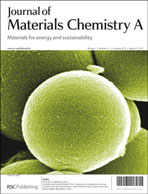Organic–inorganic hybrid bulk heterojunction (BHJ) solar cells have attracted much attention due to their low cost fabrication, flexibility, and long life. However, the compatibility between organic and inorganic materials is still an issue that needs to be solved to achieve high power conversion efficiency (PCE). The larger size and dense characteristics of inorganic nanocrystals make it hard to control the morphology and phase separation of organic–inorganic hybrid thin films by conventional processes like thermal annealing and solvent annealing. In this study, we have carried out a systematic investigation using an additive: rod–coil diblock copolymer poly(3-hexyl thiophene)-b-poly(2-vinyl pyridine) (P3HT-b-P2VP) to P3HT:TiO2 to make a ternary system. That improves the compatibility between the P3HT homopolymer and the TiO2 nanorod hybrid materials and results in enhanced performance of the hybrid solar cell. The hydrophobic characteristics of the P3HT segment of the copolymer are compatible with the P3HT homopolymer, and the P2VP segment, containing a pyridine moiety is more compatible with hydrophilic TiO2. The results of atomic force microscopy and X-ray diffraction spectroscopy studies of hybrid films reveal that the crystallization behavior of the homopolymer P3HT in the film can be tuned by incorporating different weight ratios of P3HT-b-P2VP. The efficiency of charge separation is also improved as observed by greater photoluminescence quenching. Furthermore, the power conversion efficiency of the solar cell fabricated from this new hybrid system was increased threefold as compared with the one without the additive (1.20% vs. 0.42%), which indicates that the amphiphilic P3HT-b-P2VP can effectively modulate the interfacial interactions between the conducting polymer and nanocrystals in both solution and film to have the appropriate morphology for high efficient solar cells.

You have access to this article
 Please wait while we load your content...
Something went wrong. Try again?
Please wait while we load your content...
Something went wrong. Try again?


 Please wait while we load your content...
Please wait while we load your content...